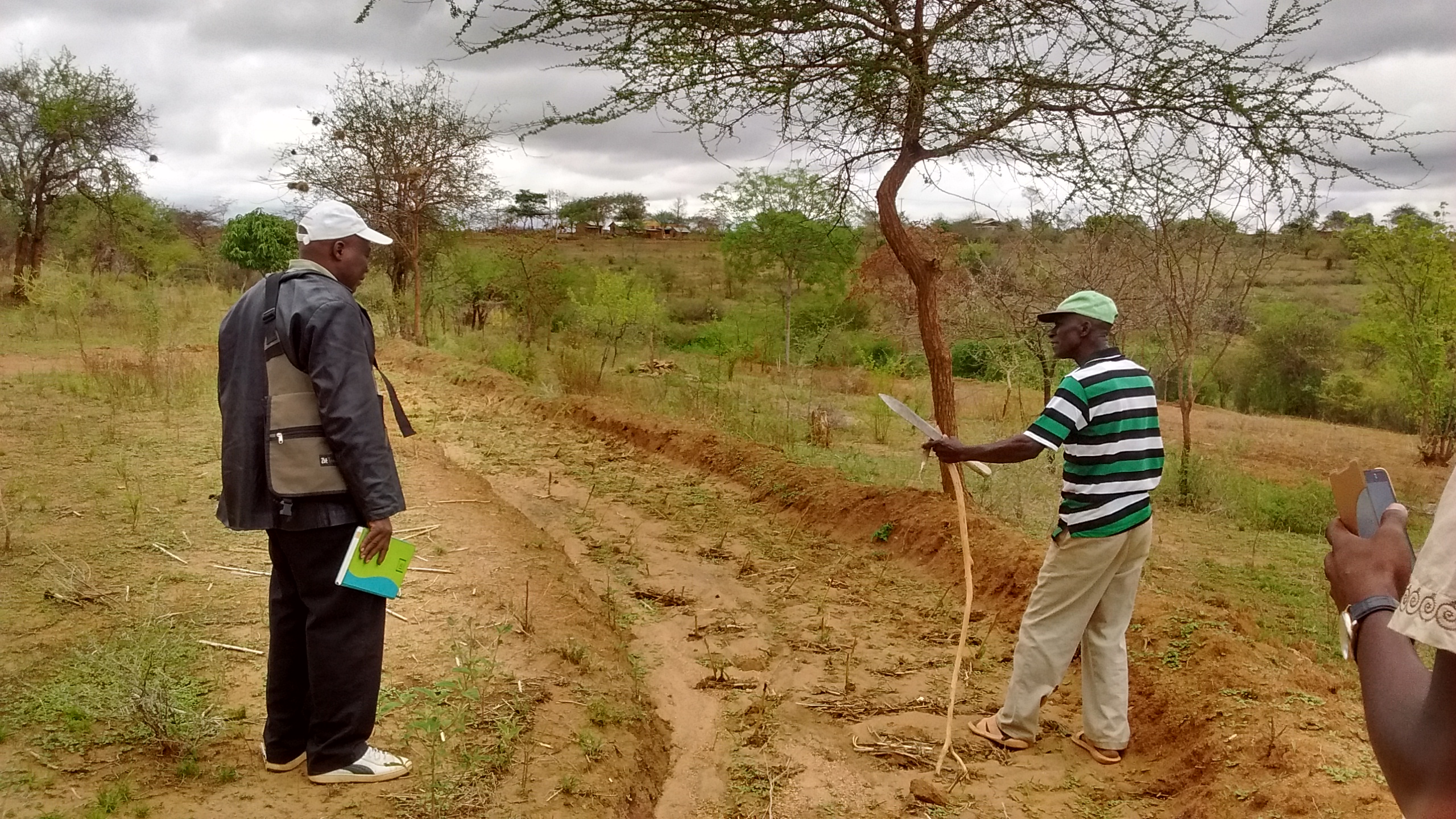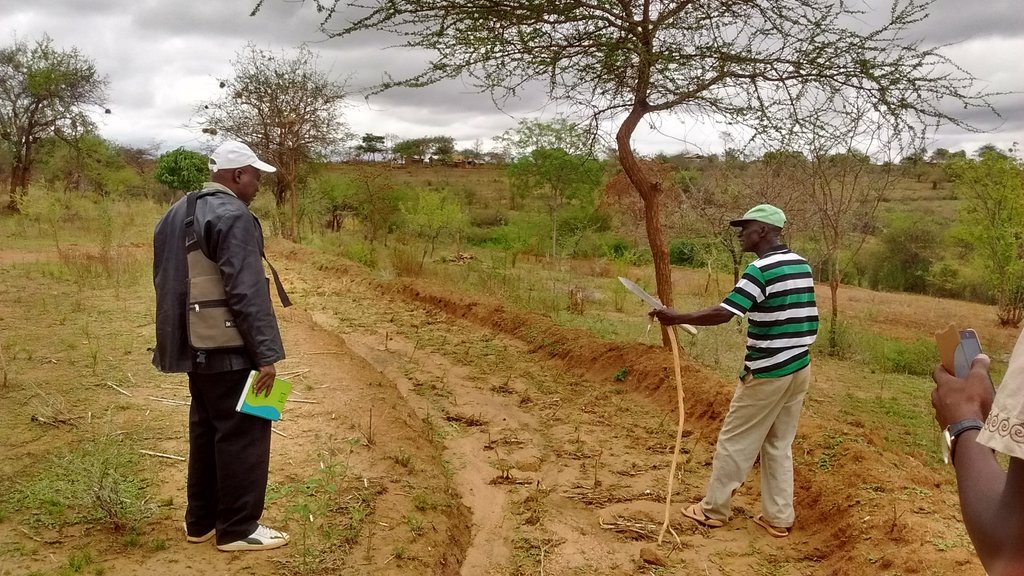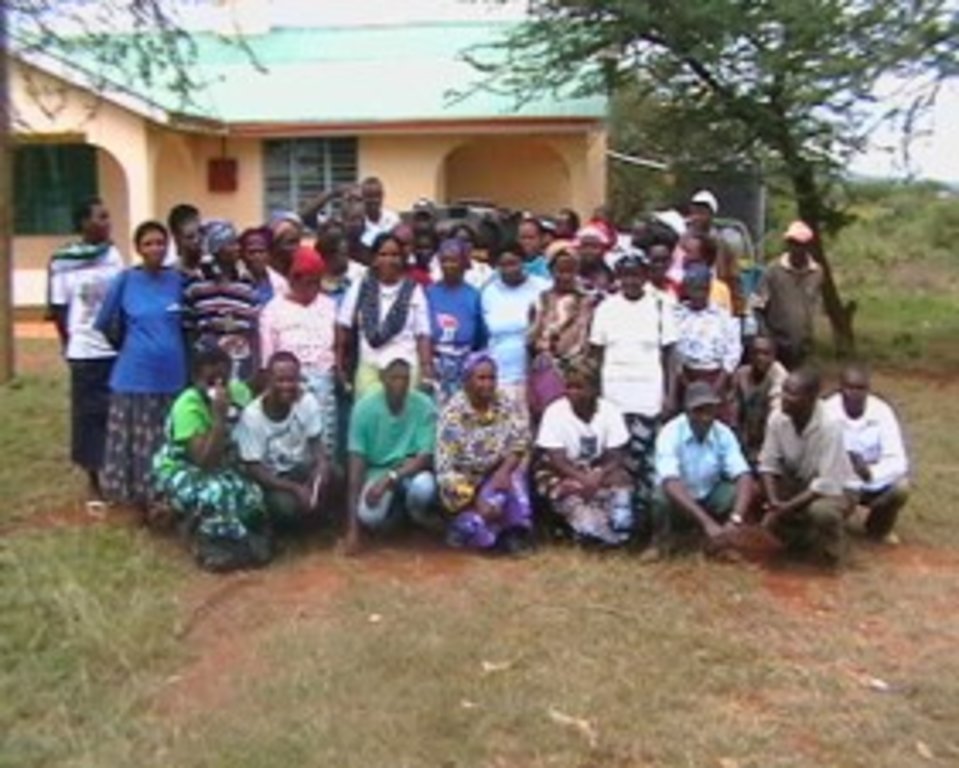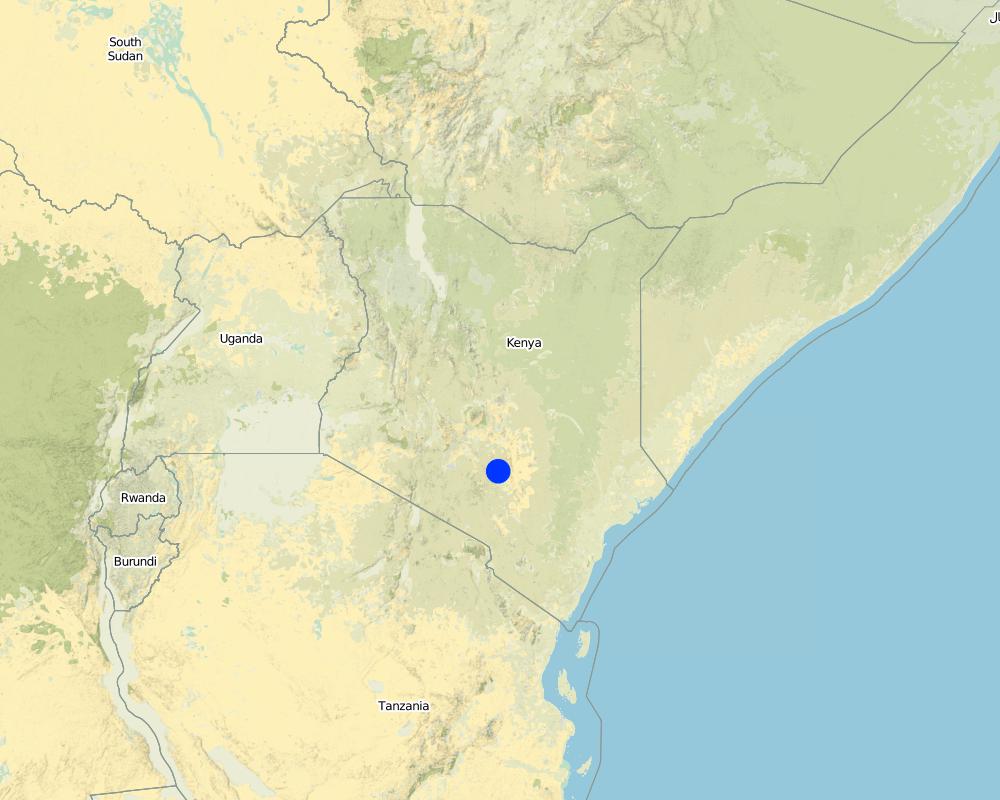On-farm indigenous pasture establishment demonstrations [كينيا]
- تاريخ الإنشاء:
- تحديث:
- جامع المعلومات: Kevin Mganga
- المحرر: –
- المراجعون: Rima Mekdaschi Studer, Hanspeter Liniger, Donia Mühlematter
On-farm demos
approaches_3285 - كينيا
- In-situ pasture establishment demonstrations: 26 يناير، 2018 (inactive)
- On-farm pasture establishment demonstrations : 21 فبراير، 2018 (inactive)
- On-farm indigenous pasture establishment demonstrations : 20 إبريل، 2018 (inactive)
- On-farm indigenous pasture establishment demonstrations : 3 سبتمبر، 2018 (public)
عرض الأقسام
توسيع الكل طي الكل1. معلومات عامة
1.2 تفاصيل الاتصال بالأشخاص الرئيسيين لمصدر المعلومات والمؤسسات المعنية بتقييم وتوثيق النهج
الشخص (الأشخاص) الرئيسي لمصدر المعلومات
متخصص في الإدارة المستدامة للأراضي:
اسم المشروع الذي سهّل توثيق/تقييم النهج (إذا كان ذلك على صلة)
Book project: Guidelines to Rangeland Management in Sub-Saharan Africa (Rangeland Management)اسم المؤسسة (المؤسسات) التي سهلت توثيق/تقييم النهج (إذا كان ذلك على صلة)
Department of Range and Wildlife Sciences, South Eastern Kenya University (SEKU) - كينيا1.3 الشروط المتعلقة باستخدام البيانات الموثقة من خلال WOCAT
متى تم تجميع البيانات (ميدانيا)؟:
10/11/2017
يوافق جامع المعلومات والشخص (لاشخاص) الرئيسي لمصدر المعلومات على الشروط المتعلقة باستخدام البيانات الموثقة من خلال WOCAT:
نعم
1.4 المراجع الخاصة باستبيان(استبيانات) تقنيات الإدارة المستدامة للأراضي
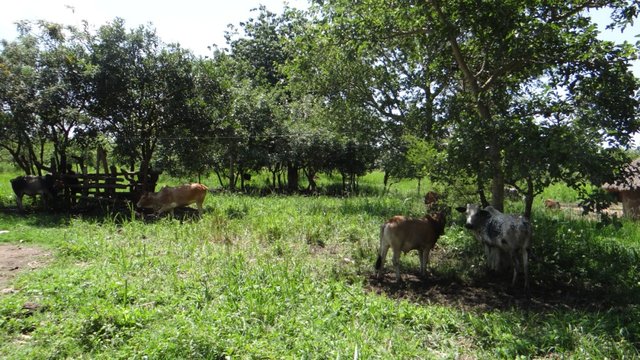
Multi-Purpose Tree Species for Pasture Supplementation [اوغندا]
Multi-purpose tree species such as Calliandra calothyrsus are planted on farmstead to improve pastures for soil fertility improvement and livestock production
- جامع المعلومات: Sunday Balla Amale
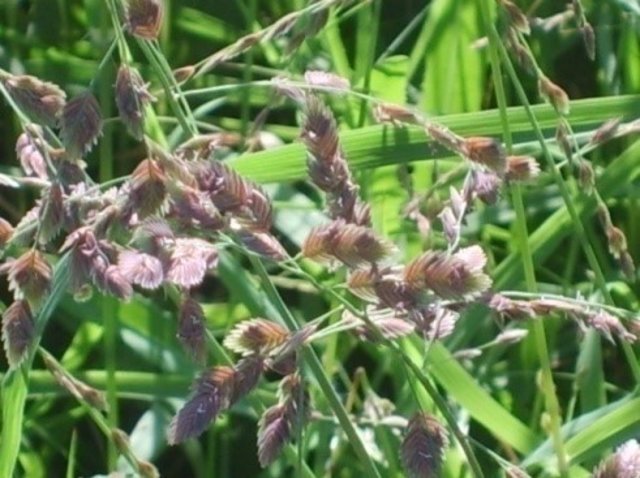
Grass reseeding [كينيا]
Grass reseeding is a sustainable land management practice aimed at rehabilitating degraded pastures and providing livestock feed. This is mainly carried out with indigenous perennial grass species.
- جامع المعلومات: Kevin Mganga
2. وصف نهج الإدارة المستدامة للأراضي
2.1 وصف موجز للنهج
On-farm indigenous pasture establishment demonstrations offer a practical approach to encourage adoption in the arid and semi-arid environments in Kenya.
2.2 وصف تفصيلي للنهج
وصف تفصيلي للنهج:
The characteristic feature of the demonstration approach is the interaction of different stakeholders in on-farm showcasing of sustainable land management technologies. The stakeholders include land users, NGOs, SLM specialists, local government officials and university researchers. SLM specialists and university researchers, with the help of local government and NGO field officers demonstrate the entire process of grass reseeding from site selection, seedbed preparation, grass species selection, weeding, monitoring and evaluation of both plant and soil parameters. The method comprises on-farm demonstrations both at individual, and pastoral and agropastoral group sites, and a model demonstration site within the university premises. The role of the main stakeholders involved in the process are sharing the knowledge, skills and technology (the SLM specialists; researchers from the university), linking the SLM specialists with the pastoral communities, sharing their experiences through on-farm demonstrations and explanations of similar technologies local government (county officials), sharing knowledge of past experiences and skills (local NGOs). The end users of the technologies, namely the pastoral communities share their indigenous technical knowledge related to natural resource management. In this case study the end-users comprised approximately 40 livestock keepers. Over five visits and through the demonstrations, they liked the approach because it was more practical being on-farm (“seeing is believing”). It was appreciated as being easily replicated on their own land under the same local conditions of climate, soil type, grass species, methods of land preparation, and land use system. After interacting with the SLM specialists from the universities during the visits and on-farm demonstrations, land-users have adopted the technology to ensure a continuous supply of pasture for their livestock.
2.3 صور عن النهج
ملاحظات عامة بخصوص الصور:
Stakeholders discussing and sharing their knowledge and skills.
2.5 البلد/المنطقة/المواقع التي تم تطبيق النهج فيها
البلد:
كينيا
المنطقة/الولاية/المحافظة:
Eastern Province
مزيد من التفاصيل حول الموقع:
Kitui municipality, Kitui county
Map
×2.6 تواريخ بدء وإنهاء تنفيذ النهج
في حالة عدم معرفة السنة بالتحديد، يرجى الإشارة إلى التاريخ التقريبي لبدء النهج:
منذ أقل من 10 سنوات (مؤخرًا)
2.7 نوع النهج
- مبادرة محلية حديثة/مبتكرة
2.8 الغايات/الأهداف الرئيسية للنهج
To demonstrate indigenous pasture establishment on-farm, and encourage land users to practice reseeding as a means of 1) rehabilitating their degraded lands, 2) providing forage for their livestock and 3) income generation through sale of surplus animal products i.e. milk, hay and seeds.
2.9 الظروف التي تمكن أو تعيق تنفيذ التقنية/التقنيات المطبقة بموجب النهج
المعايير والقيم الاجتماعية /الثقافية/ الدينية
- تمكين/تمكيني
Land users are livestock keepers so technologies and approaches to improve livestock production are welcome.
- معيق
Gender-based constraints where men dominate on-farm training/demonstrations compared to female land users.
توفر/الوصول إلى الموارد والخدمات المالية
- تمكين/تمكيني
Facilitation from previous (Agricultural Innovation for Dryland Africa, AIDA) and on-going research project (Rainwater Harvesting for Indigenous Pasture Production, ROFIP, in semi-arid Kitui County, Kenya). The current ROFIP project is under the Food and Business Applied Research Fund (ARF) funded by the he Netherlands Organisation for Scientific Research (NWO).
- معيق
Accessing money/financial resources from government/public institutions and organisation is long (much slower) due to e.g. bureaucracy and protocol, compared to private organisation (much faster access, less bureaucratic).
الإطار المؤسساتي
- تمكين/تمكيني
The university encourages extension service delivery to the local community and supports such initiatives to reach out to land users to share knowledge and expertise.
- معيق
Coordinating different stakeholders both in the private (NGO) and public sector (university, local government), together with land users is often a challenge mainly due to the different nature of operations e.g. bureaucracy, protocol.
التعاون/التنسيق بين الجهات الفاعلة
- تمكين/تمكيني
Collaboration between university, local government and local land users.
- معيق
Different stakeholders (e.g. land users, university, local government, NGOs) all have different key objectives to achieve within the general aim/objectives. This often hinders the coordination of actors and implementation of the approach.
الإطار القانوني (حيازة الأراضي، وحقوق استخدام الأراضي والمياه)
- تمكين/تمكيني
Land used in the approach for demonstrating the reseeding technology is privately owned.
- معيق
Land ownership is private, communal and group. This determines the organisation and arrangement of the approach.
حوكمة الأراضي (صنع القرار والتنفيذ والإنفاذ)
- تمكين/تمكيني
المعرفة حول الإدارة المستدامة للأراضي، والوصول إلى الدعم الفني
- تمكين/تمكيني
SLM specialists have knowledge about the SLM technologies and various approaches.
الأسواق (لشراء المدخلات وبيع المنتجات) والأسعار
- تمكين/تمكيني
- معيق
Some of the inputs especially indigenous grass seeds, are not available in the formal seed market in Kenya. Reliance on the informal seed market often leads to the purchase and use of uncertified seeds with poor end results.
عبء العمل، توفر القوى العاملة
- تمكين/تمكيني
Use of local casual labourers. This contributes to “ownership” of the project activities and easier implementation in their individual farms.
- معيق
Division of labour between the project demonstration sites and individual activities. This may lead to delays in implementing project activities.
3. المشاركة وأدوار الأطراف المعنية
3.1 أصحاب المصلحة المعنيون بالنهج وأدوارهم
- مستخدمو الأراضي المحليون/المجتمعات المحلية
local land users and livestock keepers
Share their indigenous technical knowledge; provide land for on-farm demonstrations.
- متخصصون في الإدارة المستدامة للأراضي / مستشارون زراعيون
university researchers
Describe the technologies using practical on-farm demonstrations. Additionally, share and present scientific research findings to demonstrate the contribution of the use of the technology for increased indigenous pasture production: i.e. evidence-based.
- المعلمون / أطفال المدارس / الطلاب
university students
Practical demonstrations
- منظمة غير حكومية
Local NGO (Roads for Water)
Collaborate with university researchers to demonstrate to different land users and managers (e.g. researchers, pastoral and agro-pastoral communities) how other land management strategies e.g. rainwater harvesting using roads as catchments can be incorporated in reseeding programmes to enhance pasture establishment, especially in dryland environments.
- الحكومة المحلية
Extension agents and advisors in the county government
Link to the end-users, share past experiences and knowledge on SLM approaches
3.2 انخراط مستخدمي الأراضي المحليين/المجتمعات المحلية في المراحل المختلفة للنهج
| انخراط مستخدمي الأراضي المحليين/المجتمعات المحلية | حدد من شارك وصف الأنشطة | |
|---|---|---|
| المبادرة/التحفيز | تفاعلي | Local land users involved in the site selection and involved in the plans of the project. Local land users share their indigenous technical knowledge gained through years of experience on aspects such as: which species are preferred by grazing animals (i.e. ranking of different forage species); which grass species perform better under different rainfall regimes, topography and soil types; which grass species are best suited for soil conservation and soil erosion control. |
| التخطيط | تفاعلي | Local land users actively involved in deciding on schedule for land users visits and demonstrations. Local land users participate and contribute to the planning of sowing dates, methods of land preparation, grass species selection in relation to their individual taste and preference and intended use (fodder for livestock, soil conservation and combating degradation, large-scale seed production). |
| التنفيذ | تفاعلي | Demonstration conducted on individual 'farms'/ pastures and local land users implement the technologies as 'model land users'. |
| الرصد/التقييم | تفاعلي | Constant communication through short message services (SMS) and telephone calls on progress and challenges as land users monitor changes, e.g. seed germination and seedling establishment. Local land users report this to the SLM specialists e.g. researchers in the university and post-graduate students involved in the projects. |
| Research | سلبي | Research is mainly conducted by SLM specialists at university and students. The local government is also involved in research since some of the students recruited to be part of the project: for example PhD and MSc students are permanently employed by the local government. Local land users share their indigenous technical knowledge through one-on-one informal discussions/sessions between them and the SLM specialists and students. |
3.3 مخطط التدفق (إذا كان متاحًا)
الوصف:
Interaction between different stakeholders (SLM specialists, local government, local NGOs and land users) for pasture establishment demonstrations in arid and semi-arid environments in Kenya.
المؤلف:
Kevin Z. Mganga
3.4 اتخاذ القرار بشأن اختيار تقنية/تقنيات الإدارة المستدامة للأراضي
حدد من الذي قرر اختيار التقنية/التقنيات التي سيتم تنفيذها:
- جميع الجهات الفاعلة ذات الصلة، كجزء من نهج تشاركي
حدد على أي أساس تم اتخاذ القرارات:
- تقييم المعرفة الموثقة جيدًا بشأن الإدارة المستدامة للأراضي(اتخاذ القرارات القائمة على الأدلة)
- نتائج البحوث
- خبرة وآراء شخصية(غير موثقة)
4. الدعم الفني وبناء القدرات وإدارة المعرفة
4.1 بناء القدرات/التدريب
هل تم تقديم التدريب لمستخدمي الأراضي / الأطراف المعنيين الآخرين؟:
نعم
حدد من تم تدريبه:
- مستخدمو الأراضي
- موظفون ميدانيون/ مستشارون
إذا كان ذلك على صلة، حدد الجنس والعمر والوضع والعرق وما إلى ذلك.
The land users and field staff/advisers were drawn from both genders (male and female). University undergraduate students (both male and female students, between the ages of 20-24 years) were also involved in the training during on-farm practical sessions.
شكل التدريب:
- مناطق العرض
المواضيع المغطاة:
site selection, seedbed preparation, choice of grass species, monitoring and evaluation (plant and soil attributes), maintenance and further management.
4.2 خدمة استشارية
هل يملك مستخدمو الأراضي وصولا إلى خدمة استشارية؟:
نعم
حدد ما إذا كانت الخدمة الاستشارية متوفرة:
- في حقول مستخدمي الأراضي
وصف/تعليقات:
Advisory services on-farm during visits.
4.3 تعزيز المؤسسات (التطوير التنظيمي)
هل تم إنشاء أو تعزيز مؤسسات من خلال هذا النهج؟:
- نعم، باعتدال
حدد المستوى (المستويات) التي تم فيها تعزيز أو إنشاء المؤسسات:
- محلي
- إقليمي
- وطني
صف المؤسسة والأدوار والمسؤوليات والأعضاء وما إلى ذلك.
University (South Eastern Kenya University, SEKU) - extension and outreach and research and academic exchange programs with other research institutions e.g. Kenya Agricultural and Livestock Research Organisation (KALRO), International Crops Research Institute for the Semi-Arid Tropics (ICRISAT), Kenya Seed Company, and other universities, for example the University of Nairobi (UoN).
حدد نوع الدعم:
- مالي
- بناء القدرات/التدريب
اعط مزيدا من التفاصيل:
Financial support from within university research funds and the National Research Fund (NRF), Kenya, through the Ministry of Education, Science and Technology. Capacity building through postgraduate training involving researchers from SEKU, KALRO, ICRISAT and UoN.
4.4 الرصد والتقييم
هل يشكل الرصد والتقييم جزءا من النهج؟:
نعم
التعليقات:
Adoption and uptake of the technologies among land users.
إذا كانت الإجابة بنعم، فهل من المقصود استخدام هذه الوثائق للمراقبة والتقييم؟:
نعم
التعليقات:
The approach demonstrates sustainable land management technologies e.g. grass reseeding, on farm. This is aimed at increasing adoption and spread of the technology by other land users.
4.5 البحوث
هل كانت البحوث جزءًا من النهج؟:
نعم
حدد المواضيع:
- علم الايكولوجيا
- تكنولوجيا
أعط تفاصيل إضافية وأشر إلى من قام بالبحوث:
By an SLM specialist: that is researcher at the university under a research project.
5. التمويل والدعم المادي الخارجي
5.1 الميزانية السنوية لمكون الإدارة المستدامة للأراضي في النهج المذكور
إذا لم تكن الميزانية السنوية الدقيقة معروفة، قم بالإشارة إلى نطاقها:
- 10,0000-2,000
التعليقات (على سبيل المثال المصادر الرئيسية للتمويل/الجهات المانحة الرئيسية):
Food and Business Applied Research Fund (ARF) funded by the The Netherlands Organisation for Scientific Research (NWO), Netherlands.
5.2 الدعم المالي/المادي المقدم لمستخدمي الأراضي
هل حصل مستخدمو الأراضي على دعم مالي/ مادي لتنفيذ التقنية/ التقنيات؟:
نعم
إذا كانت الإجابة بنعم، حدد نوع (أنواع) الدعم والشروط والمزودين:
Land and seed bed preparation: hiring of casual labour and rent of machinery / equipment (ox-plough / tractor).
5.3 إعانات لمدخلات محددة (بما في ذلك العمالة)
- عمالة
| إلى أي مدى | حدد الإعانات |
|---|---|
| ممول جزئيا | Cash subsidy mainly for land/site preparation e.g. creating of micro-catchments using ox-driven ploughs, digging trenches as structures for rainwater harvesting. |
- معدات
| حدد المدخلات التي تم دعمها | إلى أي مدى | حدد الإعانات |
|---|---|---|
| الآلات | ممول بالكامل | Ox-driven ploughs for site preparation. Occasionally tractors. |
| أدوات | ممول بالكامل | Hand hoes for bush clearing and site preparation. |
- زراعة
| حدد المدخلات التي تم دعمها | إلى أي مدى | حدد الإعانات |
|---|---|---|
| بذور | ممول بالكامل | Indigenous grass seeds used in the technology and approach are provided for by the project. However, seed for subsequent sowing is expected to be harvested from the established pasture sites. |
إذا كان العمل من قبل مستخدمي الأراضي مدخلاً جوهريًا، فهل كان:
- تطوعي
التعليقات:
This is mainly for maintaining, monitoring and evaluation of the on-farm sites e.g. aspects of maintaining the fence to keep of free-ranging livestock from damaging the established pastures and assisting other hired labourers e.g. in seeding.
5.4 الائتمان
هل تم توفير ائتمان في إطار نهج أنشطة الإدارة المستدامة للأراضي؟:
كلا
5.5 حوافز أو وسائل أخرى
هل تم استخدام حوافز أو أدوات أخرى لتشجيع تنفيذ تقنيات الإدارة المستدامة للأراضي؟:
كلا
6. تحليل الأثر والتصريحات الختامية
6.1 آثار النهج
هل ساهم النهج في تمكين مستخدمي الأراضي المحليين وتحسين مشاركة الأطراف المعنية؟:
- لا
- نعم، قليلا
- نعم، باعتدال
- نعم، إلى حد كبير
They owned and embraced the initiative since it involved them from the onset.
هل مكّن النهج من اتخاذ القرارات المبنية على الأدلة؟:
- لا
- نعم، قليلا
- نعم، باعتدال
- نعم، إلى حد كبير
On-farm sites are used for both demonstrations and experimental plots for research. This is mainly conducted by SLM specialists from the university and postgraduate students in close collaboration with land users (e.g. farmers) aimed at comparing different treatments for the technologies.
هل ساعد النهج مستخدمي الأراضي على تنفيذ وصيانة تقنيات الإدارة المستدامة للأراضي؟:
- لا
- نعم، قليلا
- نعم، باعتدال
- نعم، إلى حد كبير
Practical on-farm demonstrations in their individual farms.
هل نجح النهج في تحسين التنسيق والتنفيذ الفعال من حيث التكلفة لأنشطة الإدارة المستدامة للأراضي؟:
- لا
- نعم، قليلا
- نعم، باعتدال
- نعم، إلى حد كبير
Communication through SMS and phone calls, exchange of photos/videos of demonstrations through WhatsApp groups and emails.
هل نجح النهج في تعبئة/تحسين الوصول إلى الموارد المالية لتنفيذ الإدارة المستدامة للأراضي؟:
- لا
- نعم، قليلا
- نعم، باعتدال
- نعم، إلى حد كبير
Joint research grants and funds through collaborative work among stakeholders mostly between local NGOs and universities.
هل أدى النهج إلى تحسين معرفة وقدرات مستخدمي الأراضي على تنفيذ الإدارة المستدامة للأراضي؟:
- لا
- نعم، قليلا
- نعم، باعتدال
- نعم، إلى حد كبير
Through practical and hands-on on-farm demonstrations by SLM specialists.
هل أدى النهج إلى تحسين معرفة وقدرات الأطراف المعنية الأخرى؟:
- لا
- نعم، قليلا
- نعم، باعتدال
- نعم، إلى حد كبير
Local government and NGOs appreciating the technologies and serve as ambassadors of the same.
هل ساهم النهج في بناء/تعزيز المؤسسات والتعاون بين الأطراف المعنية؟:
- لا
- نعم، قليلا
- نعم، باعتدال
- نعم، إلى حد كبير
Collaboration between universities, local government, local NGOs and land users strengthened.
هل ساهم النهج في التخفيف من حدة الصراعات؟:
- لا
- نعم، قليلا
- نعم، باعتدال
- نعم، إلى حد كبير
هل ساهم النهج في تمكين الفئات المحرومة اجتماعيا واقتصاديا؟:
- لا
- نعم، قليلا
- نعم، باعتدال
- نعم، إلى حد كبير
هل أدى النهج إلى تحسين المساواة بين الجنسين وتمكين النساء والفتيات؟:
- لا
- نعم، قليلا
- نعم، باعتدال
- نعم، إلى حد كبير
Female land users involved.
هل شجع النهج الشباب/الجيل القادم من مستخدمي الأراضي على الانخراط في الإدارة المستدامة للأراضي؟:
- لا
- نعم، قليلا
- نعم، باعتدال
- نعم، إلى حد كبير
Young farmers involved. Also students in universities as part of practical field work.
هل أدى هذا النهج إلى تحسين الأمن الغذائي / تحسين التغذية؟:
- لا
- نعم، قليلا
- نعم، باعتدال
- نعم، إلى حد كبير
Improved pasture production for livestock, healthy animals.
هل أدى النهج إلى تحسين الوصول إلى الأسواق؟:
- لا
- نعم، قليلا
- نعم، باعتدال
- نعم، إلى حد كبير
Market for sale of grass seeds.
هل أدى النهج إلى تحسين قدرة مستخدمي الأراضي على التكيف مع التغيرات المناخية/الظواهر المناخية المتطرفة والتخفيف من الكوارث المرتبطة بالمناخ؟:
- لا
- نعم، قليلا
- نعم، باعتدال
- نعم، إلى حد كبير
Combining the use of indigenous drought tolerant grass species and water harvesting.
هل أدى النهج إلى توفير فرص عمل ودخل؟:
- لا
- نعم، قليلا
- نعم، باعتدال
- نعم، إلى حد كبير
Through sale of grass seeds and hay, surplus animal products (mostly milk) in seasons of plenty.
6.2 المحفز الرئيسي لقيام مستخدمي الأراضي بتنفيذ الإدارة المستدامة للأراضي
- زيادة الإنتاج
Increased pasture yields (improved livestock production)
- زيادة الربح (القدرة)، وتحسين نسبة التكلفة إلى العائد
Sale of grass seeds and hay and surplus animal products e.g. milk and healthy animals at a good market price
- الحد من تدهور الأراضي
Established pastureland reduces soil erosion and contributes to enhanced soil moisture and C-sequestration (soil ecosystem services).
- الوعي البيئي
Environmental conservation
6.3 استدامة أنشطة النهج
هل يمكن لمستخدمي الأراضي المحافظة على استدامة ما تم تنفيذه من خلال النهج (بدون دعم خارجي)؟:
- نعم
إذا كانت الإجابة بنعم، صف كيف:
Approach is practical and involves the use of already existing knowledge and skills e.g. use of ox-ploughs for site preparation is not foreign; local land users have interacted through their knowledge of the indigenous grasses.
6.4 نقاط قوة/مزايا النهج
| نقاط القوة/ المزايا/ الفرص من وجهة نظر مستخدمي الأراضي |
|---|
| Ease of understanding and appreciation because of its practical nature. |
| Approach allows a close interaction and exchange between the different stakeholders (land users, NGOs, local government officials, SLM specialists, universities) i.e. provides a science-practice link; learning by doing. |
| نقاط القوة/ المزايا/ الفرص من وجهة نظر جامع المعلومات أو غيره من الاشخاص الرئيسيين لمصدر المعلومات |
|---|
| On-farm and practical approach for easy adoption by other land users. |
| Takes advantage of group dynamics where different stakeholders share and provide immediate feedback and seek clarification throughout the process thus enriching the discussions. |
6.5 نقاط الضعف/ العيوب في المنهج وطرق التغلب عليها
| نقاط الضعف/ المساوىء/ المخاطر من وجهة نظر مستخدم الأراضي | كيف يمكن التغلب عليها؟ |
|---|---|
| Source of conflict between land user where the on-farm demonstration has been conducted and other neighbouring land users e.g. diverting runoff in the upland thus reducing the volume of rainwater reaching farms located down-slope. | Continuous capacity building, knowledge sharing and sensitization. |
| Choice of on-farm demonstration site at an individual land owner can lead to jealousies among other land users. Choice of on-farm demonstration site at an individual land owner can lead to aggravation among other land users. | Use of communal or group owned land for on-farm demonstrations. |
| Allocation of time to attend the on-farm demonstrations. The approach is often conducted before the onset of the rains, when the land users are busy preparing their own farms for sowing. This might lead to low turn-out during demonstrations. | In consultation with the land users, set the date(s) when majority of the land users are available. |
| نقاط الضعف/ المساوىء/ المخاطر من وجهة نظر جامع المعلومات أو غيره من الاشخاص الرئيسيين لمصدر المعلومات | كيف يمكن التغلب عليها؟ |
|---|---|
| Language barrier (SLM specialists and land users). | Involving a local land user/personnel to bridge the gap. |
7. المراجع والروابط
7.1 طرق جمع/مصادر المعلومات
- زيارات ميدانية، مسوحات ميدانية
20
- مقابلات مع مستخدمي الأراضي
50
7.2 المراجع للمنشورات المتاحة
العنوان، المؤلف، السنة، النظام القياسي الدولي لترقيم الكتب ISBN:
KZ Mganga, NKR Musimba, DM Nyariki. 2015. Competition indices of three perennial grasses used to rehabilitate degraded semi-arid rangelands in Kenya. The Rangelands Journal 37: 489-495
متاح من أين؟كم التكلفة؟:
The Rangeland Journal, USD 25
العنوان، المؤلف، السنة، النظام القياسي الدولي لترقيم الكتب ISBN:
KZ Mganga, NKR Musimba, DM Nyariki. 2015. Combining sustainable land management technologies to combat land degradation and improve rural livelihoods in semi-arid lands in Kenya. Environmental Management 56: 1538-1548
متاح من أين؟كم التكلفة؟:
Environmental Management, USD 38
العنوان، المؤلف، السنة، النظام القياسي الدولي لترقيم الكتب ISBN:
KZ Mganga, NKR Musimba, MM Nyangito, DM Nyariki, AW Mwang’ombe. 2015. The choice of grass species to combat desertification in semi-arid Kenyan rangelands is greatly influenced by their forage value for livestock. Grass and Forage Science 70: 161-167.
متاح من أين؟كم التكلفة؟:
Grass and Forage Science, USD 38
7.3 روابط للمعلومات ذات الصلة المتوفرة على الإنترنت
العنوان/الوصف:
Competition indices of three perennial grasses used to rehabilitate degraded semi-arid rangelands in Kenya
عنوان الرابط URL:
http://www.publish.csiro.au/rj/RJ15023
العنوان/الوصف:
Combining sustainable land management technologies to combat land degradation and improve rural livelihoods in semi-arid lands in Kenya
عنوان الرابط URL:
https://link.springer.com/article/10.1007/s00267-015-0579-9
العنوان/الوصف:
The choice of grass species to combat desertication in semi-arid Kenyan rangelands is greatly inuenced by their forage value for livestock
عنوان الرابط URL:
http://onlinelibrary.wiley.com/doi/10.1111/gfs.12089/abstract
الروابط والوحدات المواضيعية
توسيع الكل طي الكلالروابط

Multi-Purpose Tree Species for Pasture Supplementation [اوغندا]
Multi-purpose tree species such as Calliandra calothyrsus are planted on farmstead to improve pastures for soil fertility improvement and livestock production
- جامع المعلومات: Sunday Balla Amale

Grass reseeding [كينيا]
Grass reseeding is a sustainable land management practice aimed at rehabilitating degraded pastures and providing livestock feed. This is mainly carried out with indigenous perennial grass species.
- جامع المعلومات: Kevin Mganga
الوحدات المواضيعية
لا يوجد وحدات مواضيعية


